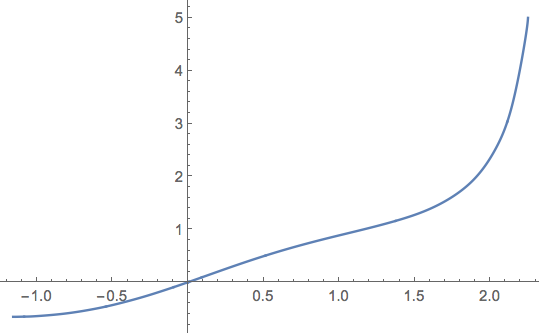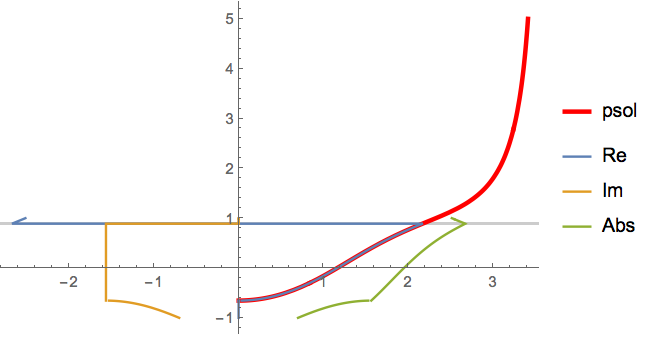The antiderivative returned by Integrate has some problems. It might be better to numerically integrate, but take care to avoid the singularity where the square-root is zero:
psol = ParametricNDSolveValue[
{x'[y] == Sqrt[(x[y]^2 - 1)^2 + alpha*x[y]], x[0] == x0,
WhenEvent[Abs[(x[y]^2 - 1)^2 + alpha*x[y]] < 1*^-6, "StopIntegration"],
WhenEvent[Abs[x[y]] > xmax, "StopIntegration"]
}, x, {y, -3, 3}, {alpha, x0, xmax},
Method -> "ExplicitRungeKutta",
"ExtrapolationHandler" -> {Indeterminate &}];
ListLinePlot[psol[0.5, 0, 5], PlotRange -> All,
InterpolationOrder -> 3]

Update: Relationship to the OP's Integrate[] result
It's clear that the definite integral
$$F(\alpha,x;a)=\int_a^x \frac{1}{\sqrt{\left(\xi^2-1\right)^2+\alpha \xi}} \, d\xi$$
will be real-valued as long as the entire interval $(a,x)$ lies in the region above Root[1 + alpha #1 - 2 #1^2 + #1^4 &, 1] or the region below
Root[1 + alpha #1 - 2 #1^2 + #1^4 &, 2].
It should also be clear that over either region, $F$ is monotonic and bounded as a function of $x$. A numerical approximation to the optimal bound may be obtained by setting xmax to the numeric equivalent of infinity, $MaxNumber, in the call to psol above. The bound will be announced in a ParametricNDSolveValue::ndsz error and will depend on the initial condition and alpha. It corresponds to a vertical asymptote in the graph of the inverse function. Similarly the time $y$ to reach the point where the square-root is zero is finite, except for $\alpha = 0$, when the expression under the radical becomes a perfect square.
Since any two antiderivatives differ by a constant, the corresponding graphs differ by a translation. The graphs of the inverse functions will differ by a horizontal translation. It's easy to translate the psol solution to overlap the one shown in @BobHanlon's answer for alpha = 0.5:
F[alpha_, x_] = (* Bob Hanlon's definition *)
Assuming[{Element[x, Reals], -1 < x < 1},
Integrate[1/Sqrt[(x^2 - 1)^2 + alpha*x], x] // FullSimplify];
p1 = Plot[psol[0.5, 0, 5][x - Re@F[0.5, 0]], {x, -1, 3.5},
PlotStyle -> {AbsoluteThickness[3], Red}, PlotRange -> All,
PlotLegends -> {"psol"}]
Block[{alpha = 0.5}, (* Bob's plot *)
p2 = ParametricPlot[
{{Re@F[alpha, x], x}, {Im@F[alpha, x], x}, {Abs@F[alpha, x], x}},
{x, -1, 1}, AspectRatio -> 1,
PlotRange -> All, Frame -> True,
FrameLabel -> (Style[#, 12, Bold] & /@ {"F[alpha, x]", "x"}),
PlotLegends -> {Re, Im, Abs}]
]
Show[p1, p2, GridLines -> {None, {0.88}}]

Extras
Here's a demo to play with the values of $\alpha$:
Manipulate[
Quiet@ListLinePlot[psol[alpha, 0, 5],
InterpolationOrder -> 3, PlotRange -> {{-3, 3}, {-1.1, 5.1}}],
{{alpha, 0.5}, 0, 1}]
To play in the other region, change the initial condition parameter x0:
Manipulate[
Quiet@ListLinePlot[psol[alpha, -2, 5],
PlotStyle -> {AbsoluteThickness[2], Red}, InterpolationOrder -> 3,
PlotRange -> {{-3, 3}, {-5.1, 0.1}}],
{{alpha, 0.5}, 0, 1}]






Block[{alpha = 1/2}, ContourPlot[x == F[y], {x, -4, 4}, {y, -1, 1}]]-- but the results are not encouraging. $\endgroup$F[x]is a complex number, so probably plottingRemakes sense. To play with alpha use Manipulate:Manipulate[ContourPlot[ Evaluate[x == Re@(F[y] /. alpha -> a)], {x, -4, 4}, {y, -1,1}], {a, -1, 1}]. $\endgroup$Integratedoes not give a discontinuous antiderivative that cannot be used to evaluate the definite integral. Is that what you want? $\endgroup$